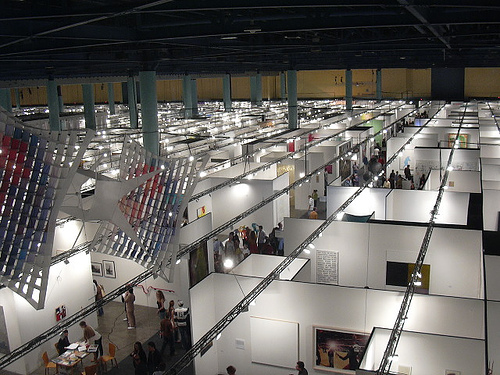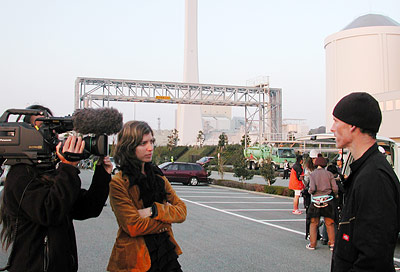December 11, 2006
Last Day Saturday
Aaron and I went in solo this day as our ladies went shopping with our hosts Harry and Leah. I had mixed feelings about it since Sharon's dad (whose house in which ae are so fortunately enjoying their generous hospitality) Harry is a fascinating gentleman who has lived quite a life. He escaped Romania walking and hitching across to Palestine, where he met his wife Leah. He participated in the movement for Independance and the formation of the state of Israel. They immigrated to French Canada and established a home building development company that was tossed in the rocky waves of the seccessionist movement, which drove him to find eventual success in Florida. Plus, he sports a remarkable counteance that reminds me of Jakie Mason fused with Frank Sinatra, leavened by a dash of Bhudda.
Europe between the wars. Israel before, after the (re)creation. Geopolitics. America and Europe. Canada. French Canada. Toronto. The USA. Florida. Real Estate Architecture and Development. Immigration, struggle and life. And life, yes life: Judaism.
Tough competiton for the fair, I'd say.
But we had yet to see the big fair. The big fair. We didn't plan it this way, but we saw worlds of artwork moving up the economic scale. We found ourselves noticing the quieter room and the softer surface underfoot. The bars, lounges and VIP rooms became roomier and more sophisticated. Security got intense, with repeated and pointed prohibition of filming anything inside either moving or still. The guards didn't seem to know what to do about cell phones. OK, I thought, no shots of the interior for the blog, then.
I went in to find Tomio Koyama, my gallery in Tokyo and my next show. Sorry folks, but I didn't wield the photographic instrument to capture an image for the blog. The visit went down without me taking out the camera as I tried not take an exploitive relation to the experience. I'm trying to keep it real, people.
I did feel compelled to steal a shot of Shintaro Miyake's performance at booth A-2, a gallery called Gerhardsen (I panned over to get a look at a Mathew Ritchie along the way):
That's right.
A beaver.
A beaver costume, that is. Shintaro underneath the costume is quite a dude: grown up, hirsute and burly. Think what you like and as you will but I take note that Shintaro's performance bubbles a childlike universe out of his drawings, through his costume and to the children ("of all ages") in the audience. Adults might not "get it" --if there is an "it" there-- but enchantment is the key to the realm with the anime aura after all.

But that's about all of the images I took of the interior of the big fair. For those of you who want a more documentary approach, check out Paddy Johnson's blog for a more journalistic exposition, good stuff. I found his picture snapped through a window from the sidewalk via Tom Moody's blog, and it looks like he too (P. Johnson) was policed by the prohibition against photography.
Tom Moody referred to the big fair in the pic as the borg, but I think all the fairs were identical schematically (not in terms of a hive, but in terms of what I would assert as a kind of humanism of the marketplace) and different only in the degree of dollars expended. What struck me about art fairs in general was that a fair is a literal compression of all of the activity in mounting a conventional gallery month long exhibit: the installation, the reception, the transaction, the deinstallation and shipping, repeat... all of this hubub one can see in the videos here... and the upshot is that contemplative space itself is squeezed out.
B'bye.
The action in the container galleries by the beach were no less mercantile and if there was a reclamation of contemplative space in the volume of a shipping container, I can't see it. The galleries who expended treasure to show artwork there were keen on doing more than breaking even. From fair to fair as you work up the price point ladder, artwork got a a little more of a bubble of contemplative space... a smidgeon, but it was there. Money can't buy you love, but maybe it can buy quality time for the art we make (we, with our lives on the line-- time=money) in our own art studio "cube farms" (wink nudge wink, T.Moody).
Aaron flagged the recent Bad at Sports podcast episode #63 for a lively discussion with longtime gallerist Rhona Haffman for topics relevant to art commerce and art fairs. Highly recommended. It starts off with a characteristic wringing of the hands over the fate of Chicago art after suffering the demise of the Chicago Art Fair and the once very good magazine, the New Art Examiner. I don't blame them for wincing from the sting, but the constant worry about the regional aspect of Chicago art isn't good for them. Hoffman's characterization about LA's regional signature as one about light seems severely dated to me as well. Sure, that was the box artists worked in for some time, but after Schimmel's 1992 MOCALA show "Helter Skelter", an appropriately dark underbelly was added to the sunny side up aspect of LA (an aspect that was always there, if you've read or seen "Day of the Locust" or "Ask the Dusk"). It was as if we added a south to a north and thus invented a compass that liberated us from the straightjacket of blue sky LA typecasting. Chicago could use its' own compass. I like the way Bad at Sports flies their freak flag but the constant Chicago refrain is getting sad.
(And therefore a note for the citizens of Miami: best to watch the gouging in local hotel rates, or you too will be crying in your beer. I heard that some hotel rooms were jacked up to upwards of $800!)

The finale for our final night in Miami was a screening for Alison Chernick's "No Restraint", which is an exquisitely subtle documentary of the making of Matthew Barney's "Drawing Restraint", his latest production. Treading between the edges of a vanity project and an exploratory documentary, Chernick maintains a gyroscopic detachment as Barney's support system (gallerists, magazines, curators, even his own father) eagerly yet bllindly demythologize the great artist that up to this point towered over New York. As the movie rolled, I thought about how the surrealists championed making the familiar strange and what happens when the strange is made familiar... about how we as an audience tend to project greatness on talent that dies young or what happens when hidden depths are plumbed with an unexpected ease... about all those oh so earnest bull headed half baked self indulgent symbol mongering artworks that train wrecked so appropriately in the surrounding studios in art school... about the difference between the work of Bjork and Barney, between the necessary figuration of musical rythmn and the difficulty inherent in the abstraction of floppily connected tropes... about others who owned similar materials such as Joseph Beuys' felt and fat and what difference lies therein... lots of thoughts.
Afterwards, it was time for drinks and dinner atop the Delano Hotel for the after party.
Dark shadows concealed alot of potential indiscretion from my camera and while the boys from Chinatown mucked about with taunts and bravado, I asked Mat Chambers to give me a tour of the skyline of this city where he went to school. Miami is a pretty nice city, in the final analysis. If I were a young artist, I would consider making my base there, a place one could grow into and become part of. There's a lot of building going on and there are many empty lots and signs on buildings for lease or rent. The art fair may go bust like Chicago but there is a basic matrix of art schools, collectors, galleries, a full flavored local Cuban culture (and the prospect of Havana going Vegas after Castro passes) and cheap rent in a fun context with a proximity to New York that's appealing.
I flew in with a canned idea: that the immensity of scale would torque our art world in problematic and interesting ways.. and I still think this is the case, but without hype and drama. We all can deal with the tsunami after all, even though it will change us in ways we cannot yet foresee. The marketplace has changed what art used to be, and maybe that isn't so bad. The dynamic of change isn't over yet to be sure, our new normal. Mega multi modal art fairs is a phenomena in transition. All the better for us artists and culture workers to keep on our toes.
Yea, Miami is a place I'd like to see again.
Posted by Dennis at December 11, 2006 9:50 AM
Leave a comment